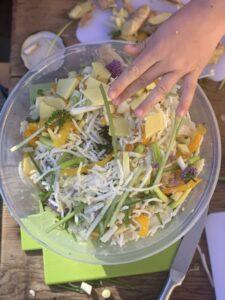
How it all Began
From waste to taste -award-winning fermented food creator and educator
For Paula Neubauer, the love affair with fermentation began when a friend gave her some water kefir grains. The Brazilian globetrotter and food aficionado was immediately hooked, fascinated by this chemical and alchemical aspect of cooking.
What was an enjoyable hobby, however, developed into a full-blown obsession after she moved to Somerset four years ago.
“l was really interested. Water kefir was my gateway to fermentation techniques,” she says. “Fermentation can transform al kinds of foodstuffs.”
Her friend also introduced Paula to the works of Sandor Katz -“he is like the godfather of fermentation’ -starting with “Wild Fermentation’.
“From that book onwards, |started doing fermentation experiments,” says Paula.
She was very keen to learn about preserves, conserves and pickles. Like many wannabe fermenters, she started with kimchi and sauerkraut. Get Pickled was born in October 2020.
“Lockdown and Brexit happened and |could see that there was so much surplus and waste in our food systems. I’d go to Asda, even at the height of lockdown queueing, and there were shelves and shelves of unwanted vegetables.
“At the same time, everyone was planting and there were bumper crops of food, and |started thinking, ‘how can we preserve this?’ says Paula.
Paula is drawn to the universality of fermentation and other food preservation techniques. Almost al cultures, around the world, have their own way of producing… cultures. In North America, they use corn fermentation, inWest Africa, they ferment about 40% of their food staples.
She is particularly interested to discover more about Chinese and Japanese fermentation, using koji.

Her aim was to lock in the goodness of vegetables in summer that would make them tasty and nutritious in winter. What started as a pastime quickly became a passion.
Even in her native Brazil, people have been fermenting food for generations in ways in which she was, until recently, unaware.
“Fermentation is present in al your foodstuffs more than you realise. For example, coffee beans are fermented: milk, cheese, yoghurt are al produced through fermentation.
“In Brazil, we have native fermented drinks that are usually made with cassava or pineapple in very traditional ways. My family is from the Amazon, and |have started looking at how they use indigenous ingredients. In particular, cassava byproducts are still a very important food.”
Cassava comes in two forms -“brava” and “mansa’. The former is highly toxic if consumed untreated, but the two forms are indistinguishable.
Paula discovered that native Brazilians put cassava in traps in the river, where they were left for at least a week, to break down the hydrochloric acid. “This makes dangerous food far less dangerous,” she says.
Paula is particularly interested in the anthropological roots of fermentation, andis conscious of the irony of developing her expertise inEurope – with all the various techniques that entails -and then returning to her culinary roots. “It’s crazy because ittook me doing fermentation and thinking about food here to go back and ask al the questions about fermentation in Brazil.”
“What attracts me to fermentation,” says Paula, “is that the more you understand, there is stil so much to know. You can be doing fermentation for almost ten years, but you are stiljust touching the surface.”
Scratching the surface or not, Get Pickled is attracting loyal customers, particularly for her Alt Kimchi and Spicy Banana Ketchup. Her products are also receiving accolades with Alt Kimchi winning a Silver Award in the 2022 Taste of the West Product Awards.
To lean more about the fab world of fermentation, plus Paula’s products, workshops and free recipe downloads, go to getpickledsomerset.com.




